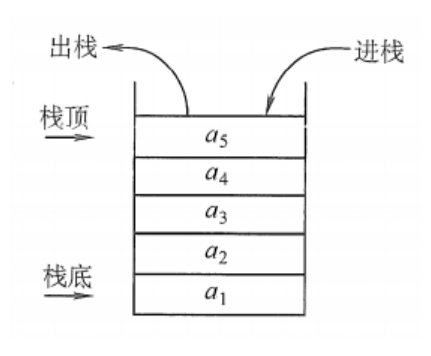顺序栈
1. 顺序栈定义
栈(Stack):是只允许在一端进行插入或删除的线性表。首先栈是一种线性表,但限定这种线性表只能在某一端进行插入和删除操作。

栈又称为后进先出(Last In First Out)的线性表。
1
2
3
4
5
6
| typedef struct Stack
{
STDataType* a;
int top; //有效数据个数
int capacity; //容量
}ST;
|
2. 顺序栈初始化
1
2
3
4
5
6
| void StackInit(ST* ps){
assert(ps);
ps->a = NULL;
ps->capacity = 0;
ps->top = 0;
};
|
3. 顺序栈销毁
1
2
3
4
5
6
7
| void StackDestroy(ST* ps){
assert(ps);
free(ps->a);
ps->a = NULL;
ps->capacity = 0;
ps->top = 0;
};
|
4. 顺序栈插入(压栈)
1
2
3
4
5
6
7
8
9
10
11
12
13
14
15
16
| void StackPush(ST* ps,STDataType x){
assert(ps);
if(ps->capacity == ps->top){ //判断容量是否足够,如果不够则增容
int newcapacity = ps->capacity ==0?4:(ps->capacity)*2;
STDataType* temp = (STDataType*)realloc(ps->a,sizeof(STDataType)*newcapacity);//扩容
if(temp == NULL){
printf("realloc fault");
exit(-1);
}
ps->a = temp; //把扩容地址传给a
ps->capacity = newcapacity;
}
ps->a[ps->top] = x; //插入元素x
ps->top++;
};
|
5. 顺序栈删除(出栈)
1
2
3
4
5
| void StackPop(ST* ps){
assert(ps);
assert(StackEmpty(ps) != 1);
ps->top--;
};
|
6. 栈顶元素查看
1
2
3
4
5
6
| STDataType StackTop(ST* ps){
assert(ps);
assert(StackEmpty(ps) != 1);
return ps->a[ps->top-1];
};
|
7. 查看栈的元素个数
1
2
3
4
5
| int StackSize(ST* ps){
assert(ps);
return ps->top;
};
|
8.判断栈是否为空 为空返回1
1
2
3
4
5
6
7
8
| int StackEmpty(ST* ps){
assert(ps);
if(ps->top == 0){
return 1;
}
else
return 0;
};
|

